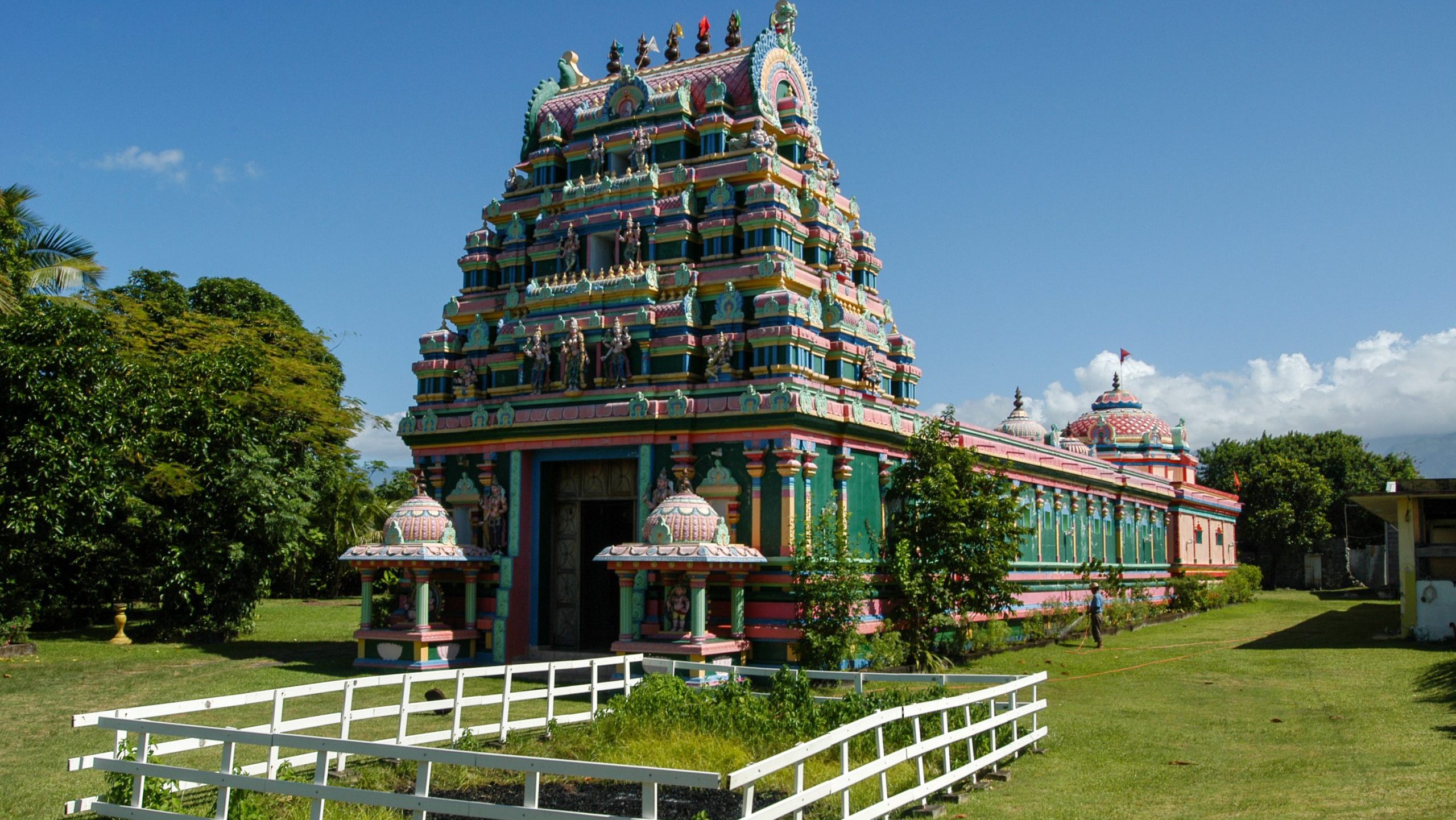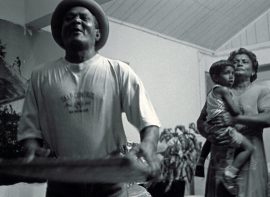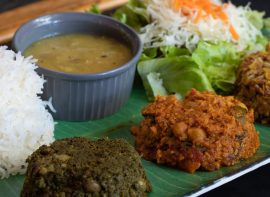

All of Réunion’s religions have found their place in a cosmopolitan society with an exemplary cultural mix.
Catholicism
Catholicism is the island’s leading religion. It is estimated that 95% of Christians are Catholics. Monsignor Aubry has been bishop since 1975. The churches scattered across the island are sometimes veritable architectural masterpieces, some of them listed as historic monuments. Here are just a few examples: Saint-Denis cathedral, Sainte-Anne church, Sacré-cœur church in Saint-Leu, Notre-Dame des laves church in Piton Sainte-Rose…
But the religious fervor of the Catholics is not confined to the houses of God: the Reunionnese show their piety just about everywhere, in the hollow of a ravine, by the side of the road. You’ll see little chapels and oratories topped by a cross, with a Vierge au parasol or a Vierge noire. People come here to make offerings, light candles and pray.
Hinduism
The rise of Hinduism on Reunion Island dates back to the second half of the 19th century. Following the abolition of slavery in 1848, the need for labor in the fields led to the immigration of many Indians, particularly from the south, such as Malabars and Tamils. This was known as “engagism”. Representations of God include Mourouga, Kali, Vishnu and Shiva.
There are ten or so large Tamil temples scattered all over the island, particularly in areas where sugar cane is grown. But there are also hundreds, if not thousands, of small public and private temples and chapels located near rivers or in the courtyards of homes.
The Tamil calendar is punctuated by many spectacular and colourful festivals:
Pandialé (fire-walking) throughout the year, depending on the temple and lunar calendar. Cavadee (around March): Ten-day festival in honor of the Tamil god Mourouga. After a period of Lent, Cavadee culminates in impressive penitential processions. Dipavali in October (Festival of Lights) Tamils celebrate New Year’s Day on April 14.
Islam
Réunion’s first Muslims (known as Zarabes) also came from India, more precisely from Gujarat, on the west coast of India. They arrived on the island from 1860 onwards, at the time of engagism. The majority of Muslims on Reunion Island are Sunni. A Shiite community arrived from Madagascar in 1972.
One of the island’s most emblematic mosques is the Noor-al-Islam (Light of Islam) mosque in Saint-Denis. Built in 1905, it is the oldest mosque in France. Located in the heart of Saint-Denis, it is open to the public.
The Muslim community is well represented. Large families are concentrated mainly in the northern region, around Saint-Denis. The most popular holidays are Ramadan and Aïd el-Fitr.
Taoism, Buddhism and Confucianism
The first Chinese arrived in 1848 as indentured laborers for the sugar industry. Perfectly integrated, they even adopted the Catholic religion for some, while sometimes retaining their original beliefs. The faithful practice their cult, a blend of Confucianism, Taoism and Buddhism, in the pagodas of Saint Denis and Saint-Pierre under the protective eye of Guan Di, Buddha, Confucius or Lao-Tzu.
The Chinese New Year celebration (at the beginning of the year, according to the lunar calendar) is an occasion for noisy demonstrations: dragons are paraded through the streets, offerings are made to the gods and the noise of firecrackers drives away evil spirits.
Popular beliefs
Popular beliefs are still very much alive in Creole culture. “Spirits” and superstitions, sometimes inherited from Africa or Madagascar, are still prevalent. Here are just a few examples:
Saint-Expédit
You’ll see little red chapels along the roadside, also known as “ti’chapelle bon Dieu”. Just stroll along and, at the bend of a ravine or lost at the bottom of a cirque, you’ll find one of these altars dedicated to Saint-Expédit, decorated with candles, plastic flowers and a Virgin or Saint-Expédit himself. Ex-votos thanking the saint are not uncommon.
This saint, found in the West Indies, South America and the Indian Ocean in general, is the object of both veneration and fear. He is known as the one who quickly grants favors (expedit), but he is an ambiguous saint, not recognized by the Church. He is often prayed to for favors, revenge or harm. Once the wish has been granted, Saint-Expedit must be paid with a gift, otherwise he will punish. In truth, Saint-Expédit appears to be a last resort for many people, especially the underprivileged in Reunion society. He is considered a Malabar saint by many, because of his red color, and his lively, vengeful, fire-like side. He is likened to Kali, the Indian goddess.
The Jako malbar is a frightening being who follows the processions, his body covered in ashes and lime painted green, wearing a red cap and a long tail. In this guise, he is said to represent the monkey god “Hanuman” (Almal). He is known for picking up coins and camphor with his mouth and performing acrobatics in the streets. He blesses homes and families and drives away evil spirits.
Sitarane
One of Reunion’s most powerful myths is based on true events. In 1909, Sitarane was part of a gang of three friends who were to become dangerous criminals with barbaric methods. They knew about the powers of Datura stramonium, the plant from which barbiturate drugs are extracted. The powder from this plant was used to make a powerful sleeping pill, which the three friends used to lull their victims to sleep before robbing their homes. For several months, burglaries and bloodthirsty crimes multiplied, and the locals took fright. Everyone was convinced that Sitarane was a sorcerer capable of invisibility and ubiquity. The legend was born during this period, when a dozen murders were attributed to them. After one of these crimes, the criminals were arrested and guillotined in the public square. The trial revealed atrocious details of the killings, macabre ceremonies, black masses… Today, Sitarane’s tomb in the Saint-Pierre cemetery is regularly visited, and many offerings are made. She is invoked for healing, protection from danger or to ward off enemies.
Grandma Kalle (or Granmèr Kal)
Grand Mère Kallz is one of Réunion Island’s best-known beliefs. This widespread belief has been so distorted that it’s impossible to find its original meaning; there are many versions. Here’s one: Grand mère kal was an old woman who used to hide convicts in her house, and when someone came near her hut she would invite him to drink coffee and a small glass of rum. If the traveler was carrying money, the convicts would follow him on his way, and when he passed the Ravine des Cafres, they would rob him and throw him into the ravine. This woman had these convicts commit so many crimes that when she died, her soul flew through the roof of her hut. Henceforth, she has no head and wears a large hat. She comes to announce death at night, hovering near the huts. She comes whenever someone is seriously ill. If she sneers in a sinister voice, she’s announcing death. (source: IRT) Whatever the version, her story is often used to threaten children if they don’t behave.



